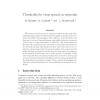Free Online Productivity Tools
i2Speak
i2Symbol
i2OCR
iTex2Img
iWeb2Print
iWeb2Shot
i2Type
iPdf2Split
iPdf2Merge
i2Bopomofo
i2Arabic
i2Style
i2Image
i2PDF
iLatex2Rtf
Sci2ools
VALUETOOLS
2006
ACM
2006
ACM
Thresholds for virus spread on networks
We study how the spread of computer viruses, worms, and other self-replicating malware is affected by the logical topology of the network over which they propagate. We consider a model in which each host can be in one of 3 possible states - susceptible, infected or removed (cured, and no longer susceptible to infection). We characterise how the size of the population that eventually becomes infected depends on the network topology. Specifically, we show that if the ratio of cure to infection rates is larger than the spectral radius of the graph, and the initial infected population is small, then the final infected population is also small in a sense that can be made precise. Conversely, if this ratio is smaller than the spectral radius, then we show in some graph models of practical interest (including power law random graphs) that the final infected population is large. These results yield insights into what the critical parameters are in determining virus spread in networks.
Related Content
| Added | 14 Jun 2010 |
| Updated | 14 Jun 2010 |
| Type | Conference |
| Year | 2006 |
| Where | VALUETOOLS |
| Authors | Moez Draief, Ayalvadi J. Ganesh, Laurent Massoulié |
Comments (0)

